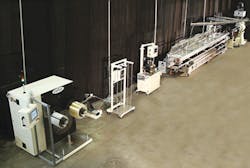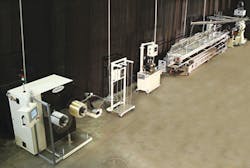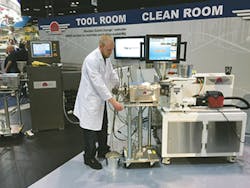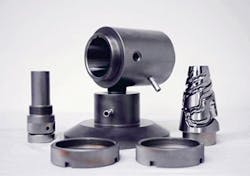Extrusion machinery suppliers demonstrated developments for medical tubing at last month's Medical Design & Manufacturing West/Plastec West show in Anaheim, Calif.
Two equipment suppliers are targeting small-diameter tubing, which is being formed with ever-smaller diameters. Products made from tiny tubing that are seeing rising demand include brain catheters and neurovascular and neurostimulation devices, said Steve Maxson, director of business development for medical at Graham Engineering Corp., York, Pa.
In addition, another extrusion equipment supplier showed a new, quick-change extrusion head for a wide range of applications.
COLLABORATION YIELDSSPECIALIZED LINES
A continued long-standing partnership between extrusion machine and controls manufactur Davis-Standard LLC, Pawcatuck, Conn., and auxiliary equipment maker Conair Group,
Cranberry Township, Pa., is experiencing continued growth in the medical tubing systems business, said Kevin Dipollino, product manager for Davis-Standard's pipe, profile and tubing systems.
Davis-Standard designs, develops and distributes extrusion and converting technology. Conair offers MedLine, its comprehensive lineup of auxiliary equipment specifically designed for clean rooms. The two companies offer medical tubing systems consisting of David-Standard's Medical Extruder Direct Drive (MEDD) series and Epic III controls, coupled with ancillary equipment from Conair's MedLine.
Davis-Standard said it has sold one of these medical tubing systems to a client in China that processes fluorinated ethylene propylene (FEP) and poly-l-lactide acid (PLLA) with embedded stripes. These stripes are encapsulated in the wall of the tubing. It also has sold numerous systems to a global client looking to run a high-speed fluorinated PVC tubing system. Dipollino said that a customer from Argentina purchased a medical tubing line after running trials and per- forming proof-of-concept testing inthe Davis-Standard clean room in their technical center. Davis-Standard installed a clean room and medical lab system at its tech center. The clean room was established in Pawcatuck last year.
Davis-Standard and Conair partnered with Zumbach Electronics Corp., Mount Kisco, N.Y., at MD&M to demonstrate a medical tubing system. The system extruded PU tubing featuring a double-D design, consisting of two lumens with a septum between the two channels. The tubing, called bump tubing, has variable diameters along its length. When the tube is cut to length, one end of the tube is larger than the other.
The first machinery component in the line was a Conair MicroWheel desiccant dryer for the PU. Next was a Davis-Standard MEDD extruder with a 19.05mm- screw diameter featuring the company's eVue PLC-based control and data-acquisition system. The material was melted and extruded as tubing from the extrusion die into a Conair MedVac vacuum cooling/sizing tank.
The tubing exited the cooling/sizing tank and passed through a three-axis outer-diameter (OD) gauge from Zumbach Electronics, then was cut with a Conair puller/cutter. Lastly, a Conair medical takeaway belt conveyer carried the lengths away. The Zumbach gauge communicated with the Davis-Standard control system to provide closed-loop control between the extruder, puller and vacuum sizing tank to assure tubing size and tight tolerances.
Special features of the demonstration line included use of a vacuum in the cooling tank. According to Bob Bessemer, Conair sales manager for medical extrusion, the creation of bump tubing — which involves changing the outer diameter of the tubing by adjusting the puller speed and puller-belt gap — requires a large opening in the cooling tank to accommodate the part of the tubing with the largest diameter. "That larger opening can also allow water to drool out. And because we place the cooling tank so close to the die on the extruder, that cooling water could spill onto the die face and affect temperature control. So we use a low-level vacuum in the tank to keep the water in," said Bessemer.
Another innovation is the air-feed bushing on the Conair puller/cutter. Conair developed a small air ring that helps guide the flexible tubing during cutting and moves the tubing forward after cutting. The air ring also ensures precise cutting to length. Overall, it helps the processor handle flexible, small-diameter tubing. The puller/cutter also features a polytetrafluoroethylene (PTFE) sleeve to allow the tubing to move freely. The line is designed to produce tubing with tight tolerances for OD, inner diameter (ID), ovality and concentricity.
Conair's MedLine includes conveying, storage, drying, blending and heat-transfer equipment. It is factory-calibrated to meet regulatory requirements and validated with documentation.
MICROEXTRUDERTARGETS TINY TUBING
The Microextruder series of small-diameter screw extruders from Graham Engineering is increasingly in demand for the production of extruded medical tubing for minimally invasive neurosurgery, said Maxson.
These extruders are designed to handle ultra-low production volumes. The Microextruder series has smaller-diameter screws to minimize material residence time and avoid material degradation, and can have output volumes as low as 125 grams per hour, Maxson said. The modular Microextruder comes with screws with diameters of 12mm, 16mm and 19mm for extruding single-layer microbore tubes with an OD ranging from 0.406mm to 2.54mm, Maxson said. The Microextruder is available with L:D ratios of 20:1 and 24:1.
Features include pressure control and servo drive or direct-drive systems. The modularity of the system allows for quick changes of barrel diameters or screw L:D ratios, for fast product changes. The Microextruder line is designed with a small die head with a diameter of 6.35mm for better control of shape and the production of small throughputs. The system is designed with the crosshead, extruder, adapter plate and pressure control optimized for small tubing. Melt pumps are not recommended but offered as an option. Automatic die centering, developed from Graham's blow molding machinery, is incorporated to help keep tube wall uniformity to within 95-99 percent of set concentricity.
Graham also offers the Microextruder as a coextrusion system, in which two or three modular Microextruders are mounted on a common base, with each machine located on linear rails for precise alignment and easy access for cleaning.
The Microextruder series can produce tubing with an outer diameter of about 0.025mm. Maxson said the Microextruder is being used in a tubing application requiring a 3.81mm ID and 8mm OD. In that application, the extruder is part of a complete system, with a vacuum sizing tank with ultrasonic measurement and a puller/cutter that doubles as a key closed-loop point of control. The continuous microextrusion system replaces a labor-intensive dip-molding process, because it has the ability to produce high-quality parts in low volumes.
Maxson said that growth in small-part medical applications drives demand for microextruders. For example, intravenous catheters that require microtubing with coextruded encapsulated radiopaque stripes, or neonatal IV catheters can be miniaturized, down to dimensions of 0.635mm OD by 0.457mm ID.
NEW QUICK-CHANGE EXTRUSION HEAD
Also at MD&M, Guill Tool & Engineering Co. Inc., West Warwick, R.I., introduced Bullet II, a quick-change extrusion head that requires no locking nuts or bolts, which shortens assembly and disassembly times.
Following the introduction of the Bullet extrusion head last year, the new extrusion head features a fixed-center design, multiport spiral flow design and a function Guill calls gum-space adjustment.
With no fastening hardware, Bullet II prevents leaks and makes cleaning and restart easier and faster, compared to conventional extrusion heads. A tapered body and deflector design pioneered by Guill also prevents leaks.
Bullet II features a threaded retaining ring for the die and a threaded tip retainer. The tip is designed to be removed from the back while the die is removed from the front of the unit. A new patent-pending cam lock deflector retaining system makes it easy to remove and install the deflector and tip, which simplifies cleaning while reducing downtime and lowering operating costs.
Bullet II is designed for low- or high-volume extrusion applications and is offered with a family of crosshead designs, said sales manager Bill Conley. A vacuum chamber and kit for assembly and disassembly are included with the unit.
Mikell Knights, senior correspondent
Contact:
Davis-Standard LLC, 860-599-1010, www.davis-standard.com
Conair Group, 724-584-5500, www.conairgroup.com
Graham Engineering, 717-848-3755, www.grahamengineering.com
Guill Tool & Engineering Co. Inc., 401-828-7600, www.guill.com



